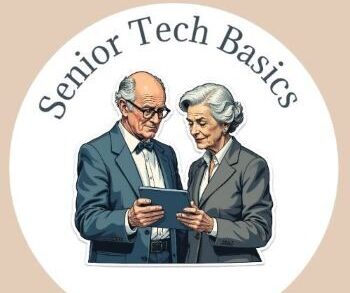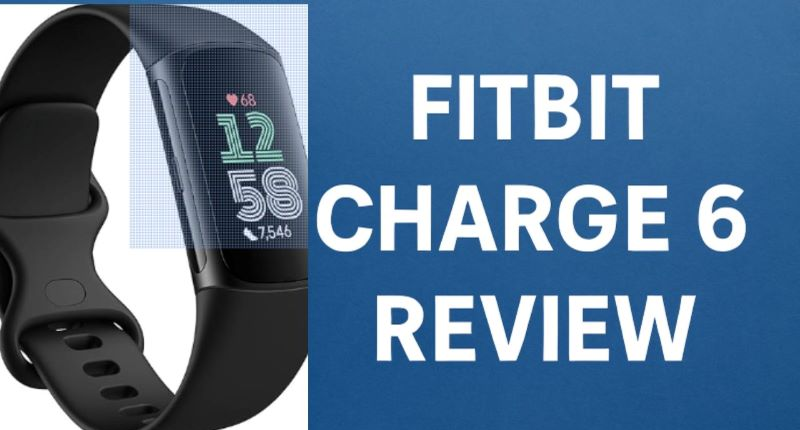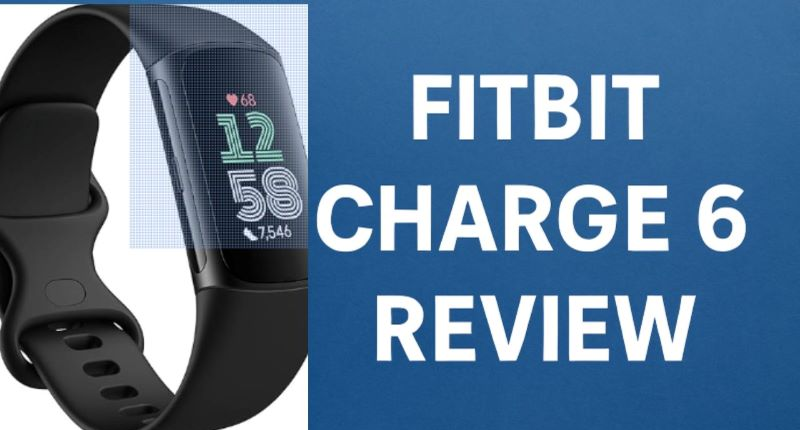
Fitness trackers have become mini health companions that help people monitor their heart rate, sleep patterns, activity, and even stress levels. Still, as an older adult, you may wonder: Is the Fitbit Charge 6 a Good Fitness Tracker for me or someone I care for?
This in-depth review describes how the Fitbit Charge 6 performs for older adults, particularly those seeking a more intuitive way to track their health without using confusing screens or complicated apps.
Whether it’s tracking your heart rate, improving your sleep, or simply staying more active, this guide will help you understand how the Fitbit Charge 6 works and whether it meets the needs of older users for a healthy lifestyle.
What Makes a Fitness Tracker Senior-Friendly?
Some fitness trackers feature tiny icons, hard-to-read screens, or resemble tech toys than health tools, making them challenging to use. That’s why you should ask whether the one you want to choose fits your daily needs.
The qualities that matter most when evaluating a senior-friendly fitness tracker include:
Clear Screen and Simple Navigation.
Older adults often prefer fitness trackers with larger text, bold visuals, and high-contrast displays, such as the Charge 6, equipped with a noticeably brighter and easier-to-read AMOLED touchscreen than earlier Fitbit models.
Choosing a device that offers intuitive swipe gestures and responsive touchscreens also helps reduce frustration. The Charge 6 features a side button for quick access and maintains a fairly straightforward menu layout, making it easy for newcomers to technology to manage.
Health Tracking, comfort, and Battery Life.
A good tracker should offer reliable data to track workout performance, heart rate insights, sleep patterns, ECG readings, and even stress management without requiring constant checking or adjustments.
A senior-friendly device should also be lightweight, comfortable to wear for extended periods, and not require daily charging. The Fitbit Charge 6 boasts a battery life of up to 7 days and multiple band options.
Low-Tech Setup and Compatibility.
Related Content: Best Fitness Trackers for Older Adults.
Ideal trackers pair easily with both Android and iPhone, and don’t require excessive syncing or app switching. Fitbit’s app setup has improved in recent years, although first-time users may still need a setup guide or technical support.
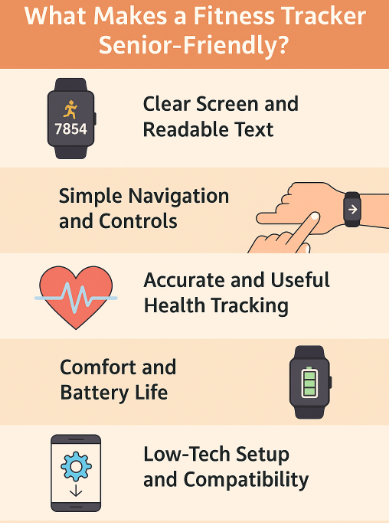
Key Features.
The Fitbit Charge 6 features give you insights into your daily activity, heart health, sleep, and more.
24/7 Heart Rate Monitoring with High and Low Alerts.
The Charge 6 continuously tracks your heart rate throughout the day and night, providing helpful real-time alerts if your heart rate exceeds or falls below a healthy range while you are at rest, right on your wrist.
Alerts help bring attention to potential health issues early, particularly if you have a heart condition that requires regular monitoring. You can even export your heart rate data and share it with your doctor.
ECG App for AFib Detection.
The built-in electrocardiogram (ECG) app enables you to monitor for signs of atrial fibrillation (AFib), a common yet serious heart rhythm disorder affecting older adults.
Hold your fingers on the side of the tracker for 30 seconds to display your heart rhythm and determine if it detects anything unusual.
- A Fitbit Charge 6 app saves the results, which you can export for medical review.
- This device is FDA-cleared and easy to use.
Sleep Score and Sleep Stage Tracking.
Many older adults struggle with sleep issues, including difficulty falling asleep, staying asleep, or waking up too early.
The Fitbit Charge 6 provides:
- A daily sleep score, from 0 to 100, based on how long and how well you slept.
- Insights into sleep stages: light, deep, and REM sleep.
- Tips for improving your sleep over time, based on your habits.
You can learn more about sleep and aging patterns from the National Institute on Aging.
Stress Management Tools with Guided Breathing.
The Charge 6 helps track your body’s stress signals through heart rate variability and offers:
- A daily stress score.
- Guided breathing exercises of up to minutes long.
- Reminders to take mindful moments when stress levels spike.
7-Day Battery Life.
The Fitbit Charge 6 battery doesn’t need daily charging due to its 7-day charging life. Wear it overnight for sleep tracking and during the day without needing to take it off to charge constantly.
This reduces stress and makes it easier to stay consistent, especially if memory or routine is a concern.
Bright AMOLED Touchscreen with Large Icons.
This device also features a sharp, colorful, and easy-to-read display, even in direct sunlight. Large icons, swipe navigation, and a responsive screen make it easy for you to check your steps, heart rate, or battery level at a glance.
You can also customize the functions to appear on your home screen, which keeps things clean and distraction-free.
Related Content: How to Use a Fitness Tracker Daily Without Feeling Overwhelmed?
Water-Resistant for Everyday Wear.
A water resistance rating of up to 50 meters makes the Charge 6 safe to wear while washing hands, showering, or even swimming. You won’t have to keep taking it off or worry about minor splashes; avoid pressing buttons underwater, and dry it thoroughly if you have sensitive skin.
You can pair this device with the Fitbit app to view all your stats in one place on your iPhone or Android smartphone.
The app connects with:
- Google Maps (for directions.
- Google Wallet for contactless payments, if you wish.
- And even YouTube Music for controlling your phone’s audio.
However, most older adults won’t need all of those extras; consider ignoring or disabling features you don’t use.
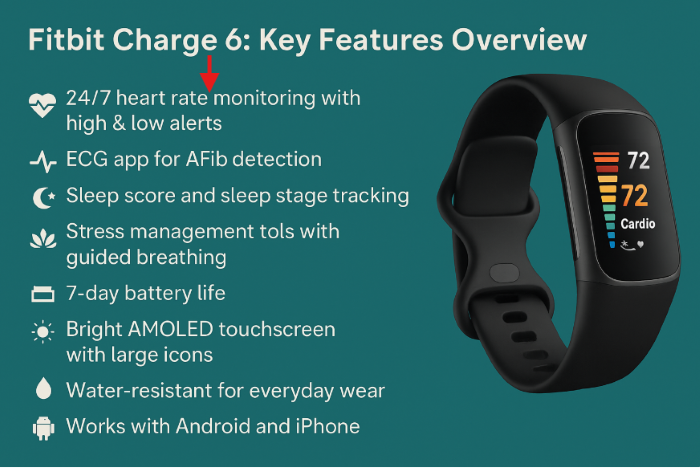
Usability for Older Adults.
The Fitbit Charge 6 features high-tech tools, while its user experience enables older adults to stick with it.
Setup and Pairing.
Setting up the Fitbit Charge 6 generally involves:
- Charging the device.
- Download the Fitbit app on your smartphone.
- Pair the tracker via Bluetooth.
This process typically takes around 10 to 15 minutes for tech-savvy seniors. You can also request help during app setup or access Fitbit’s step-by-step guides for assistance.
Screen and Navigating Menus for Daily Use.
This device features a vibrant and easy-to-read AMOLED display, with large, high-contrast icons that allow you to check your heart rate, step count, or battery level with a few taps.
The side button provides quick access to shortcuts, such as workouts or ECG scans. Some older adults might accidentally press it while adjusting the strap, which is a minor learning curve.
The Fitbit app on Android and iPhone shows:
- Daily step and heart rate history.
- Sleep scores and stress tracking.
- Health trends over time.
Tip: You don’t have to explore every screen to benefit from it. Customize which stats appear on your home screen to keep it simple.
Battery Reliability.
A battery can last up to 7 days on a full charge, meaning you will likely charge your device once a week, which is ideal if you prefer a “set it and forget it” routine.
This lightweight and slim device also comes in two band sizes, featuring soft, stretchy bands that are ideal for individuals with arthritis or sensitive skin.
Related Content: Top Wearable Devices for Monitoring Senior Health.
Pros and Cons.
The Fitbit Charge 6 from a senior’s perspective includes:
Pros:
- 24/7 AFib detection via ECG, and high/low heart rate alerts providing reliable data to support your doctor’s care plan.
- Easy-to-use AMOLED screen, with large icons and bold numbers.
- Comfortable and lightweight band that won’t irritate your skin.
- Long Battery Life of up to 7 days, allowing for charging once a week.
- Good app support and tracking history.
- A Fitbit app stores detailed records of steps, sleep, heart rate, and more, which you can share with your caregivers or doctors.
Cons:
- No fall detection or emergency SOS, unlike the Apple Watch SE or the WellBe Watch.
- Features like the ECG or notifications require pairing with a smartphone.
- The app Interface can overwhelm you at first.
- Premium features require a subscription.
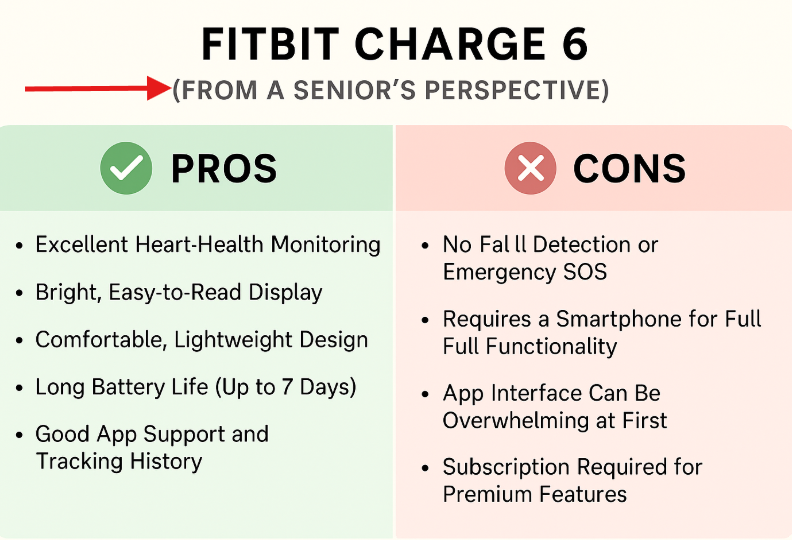
==> Check the latest price on Amazon.
Fitbit Charge 6 Vs. Other Trackers for Seniors.
The Fitbit Charge 6 is not the only fitness tracker; you may choose another depending on functions, such as heart health, ease of use, emergency alerts, battery life, and more.
Here’s how this wearable compares to a few senior-friendly alternatives:
Apple Watch SE 2nd Gen.
- Best for: Seniors who want fall detection and Emergency SOS
- The Apple Watch SE offers features Fitbit lacks, including automatic fall alerts and the ability to call emergency services from your wrist.
- A larger and easier-to-read screen.
- The battery lasts just 18 hours.
- More expensive than the Charge 6, but essential for seniors living alone.
WellBe Emergency Alert Watch.
- Best for: Seniors who prefer a standalone device with simple functionality.
- Built specifically for older adults and doesn’t require a smartphone.
- Emergency alert buttons, fall detection, reminder prompts, and caregiver features.
- Lacks advanced health tracking like ECG or sleep scores.
- Basic and non-touch screen for seniors.
Garmin Vivosmart 5.
- Best for: Seniors who want simplicity and long battery life.
- Provides reliable step, heart rate, and sleep tracking in a compact form.
- Button-based navigation for those uncomfortable with touchscreens.
- Lack of ECG, stress tracking, or a color display, unlike the Fitbit Charge 6.
Is the Fitbit Charge 6 a Good Fit for Older Adults?
The Fitbit Charge 6 offers a strong balance of innovative technology and senior accessibility from setup and usability to health features, and real-life performance.
This wearable lacks emergency call features and may require assistance during setup. Still, it can be a reliable daily companion to monitor your heart health and stress, understand sleep quality, stay active, and be motivated.
Choose the Apple Watch SE or WellBe Smartwatch if you need advanced features such as fall detection or standalone emergency alerts.
